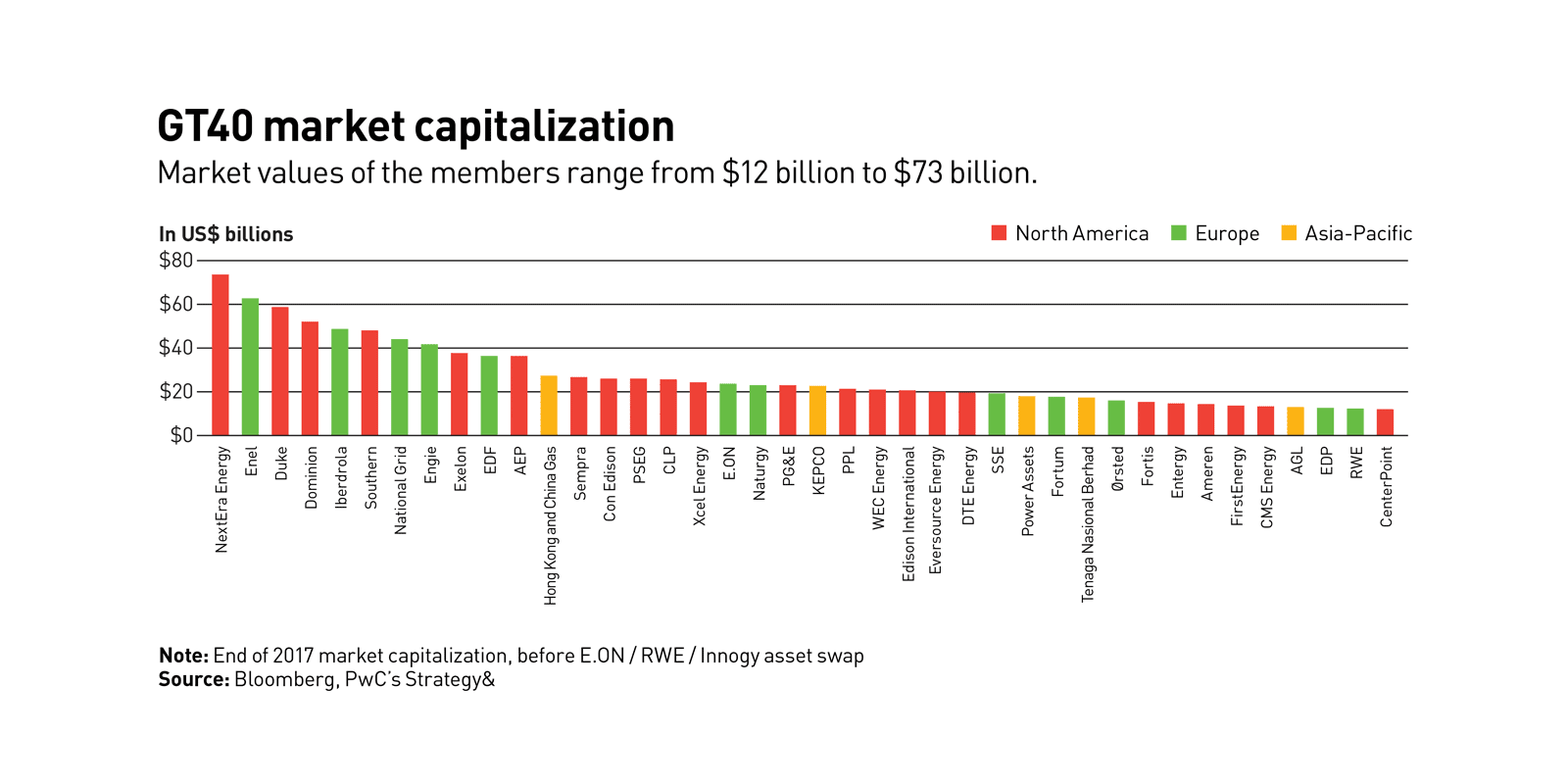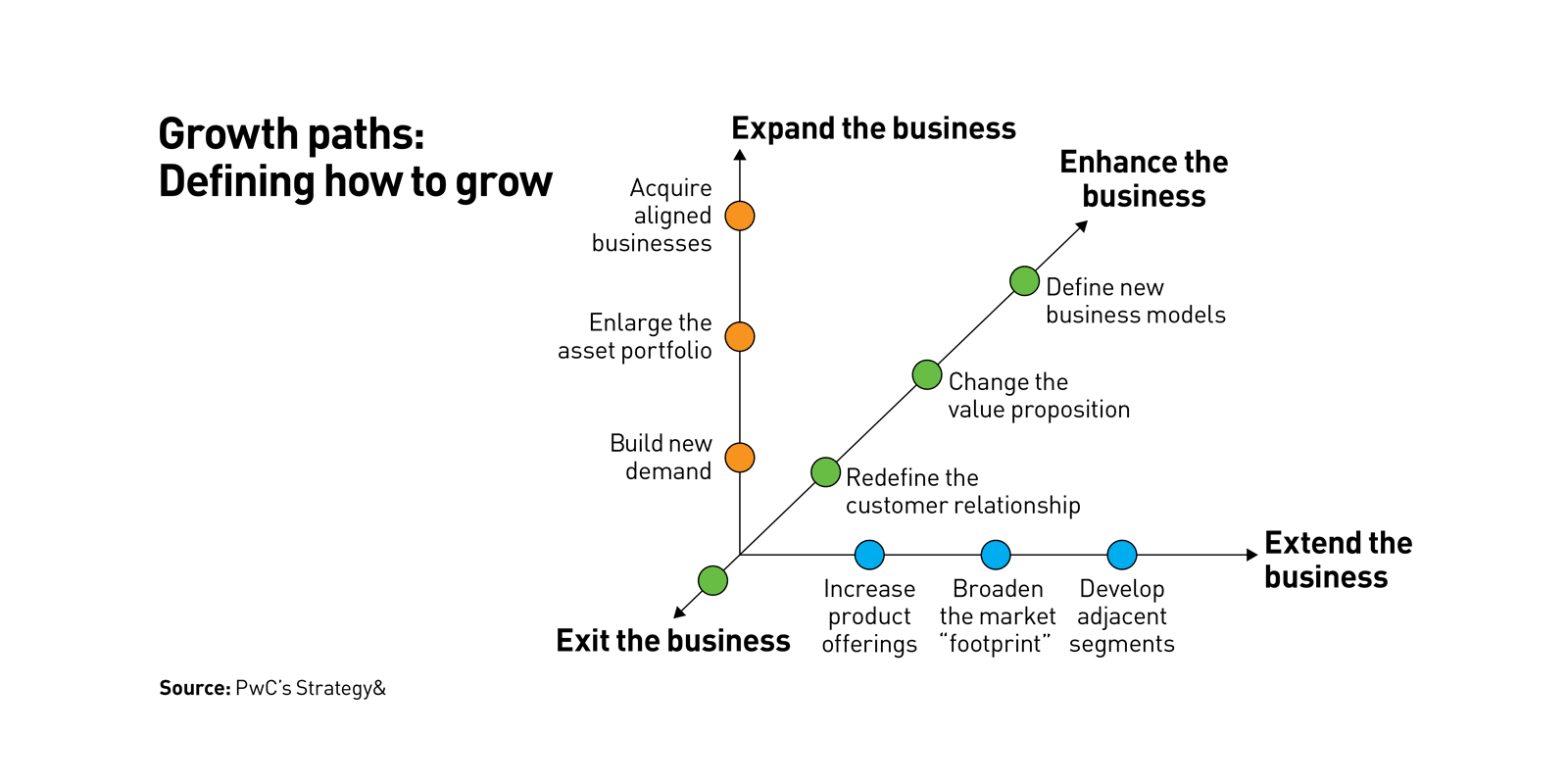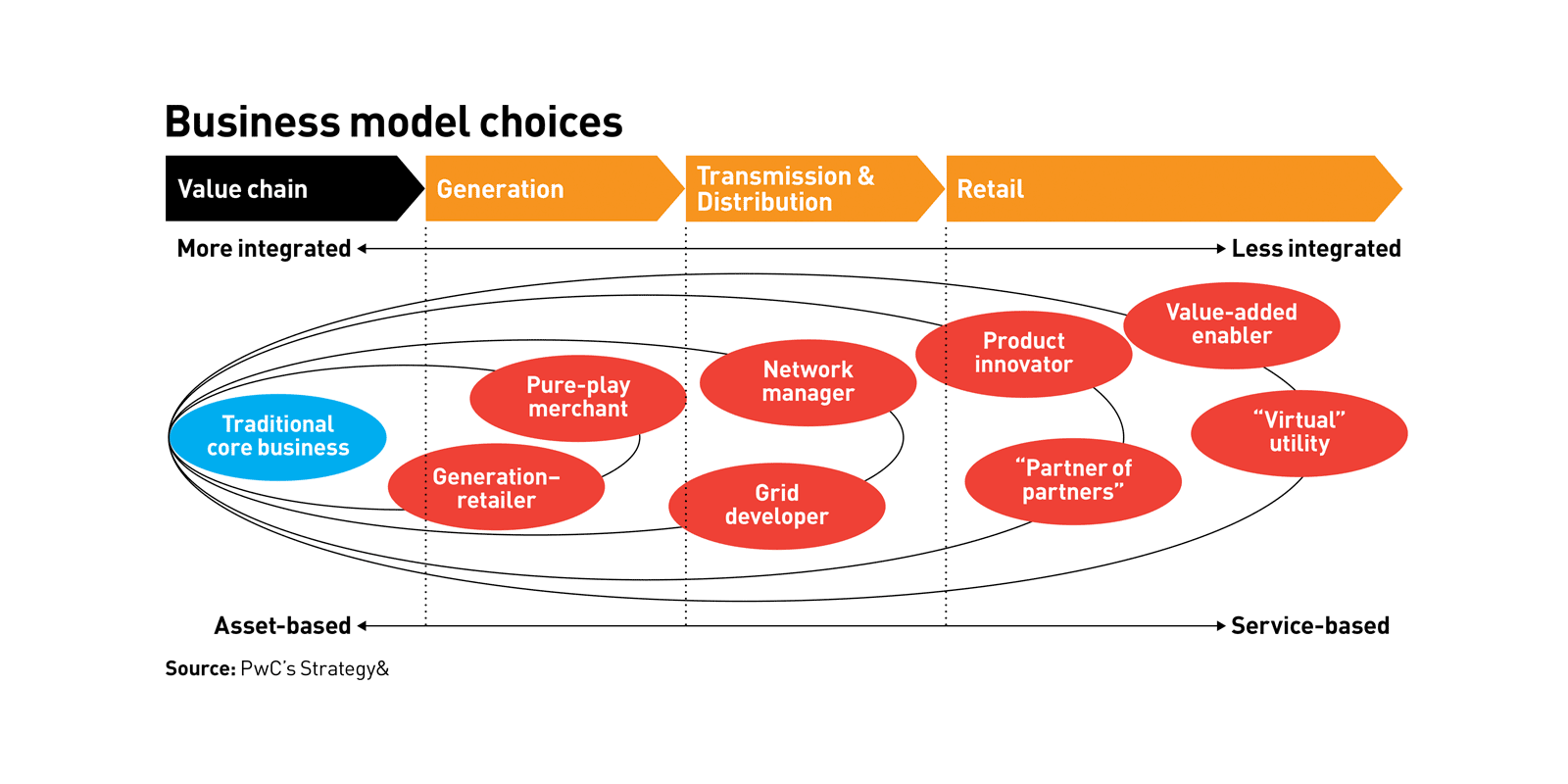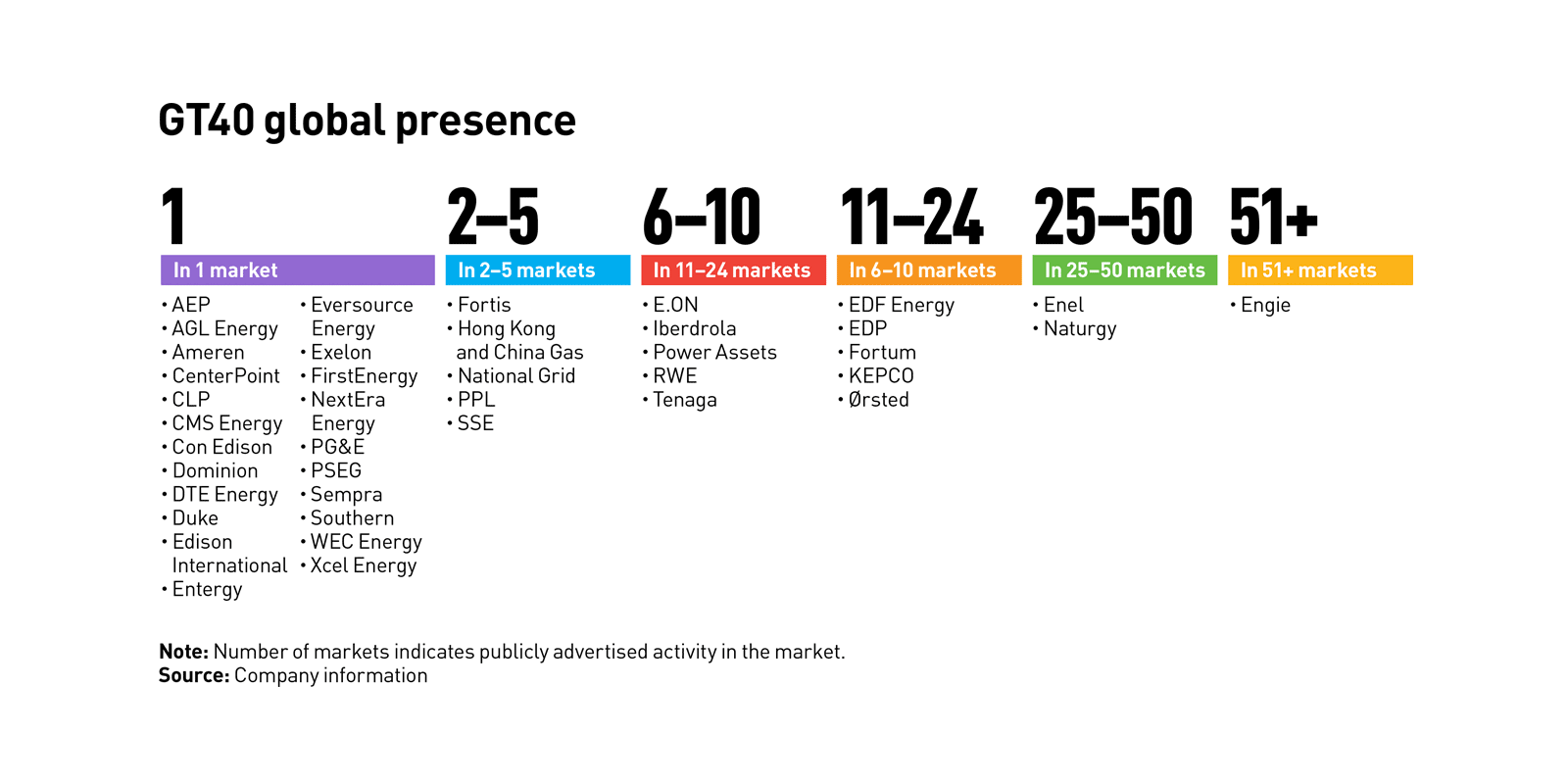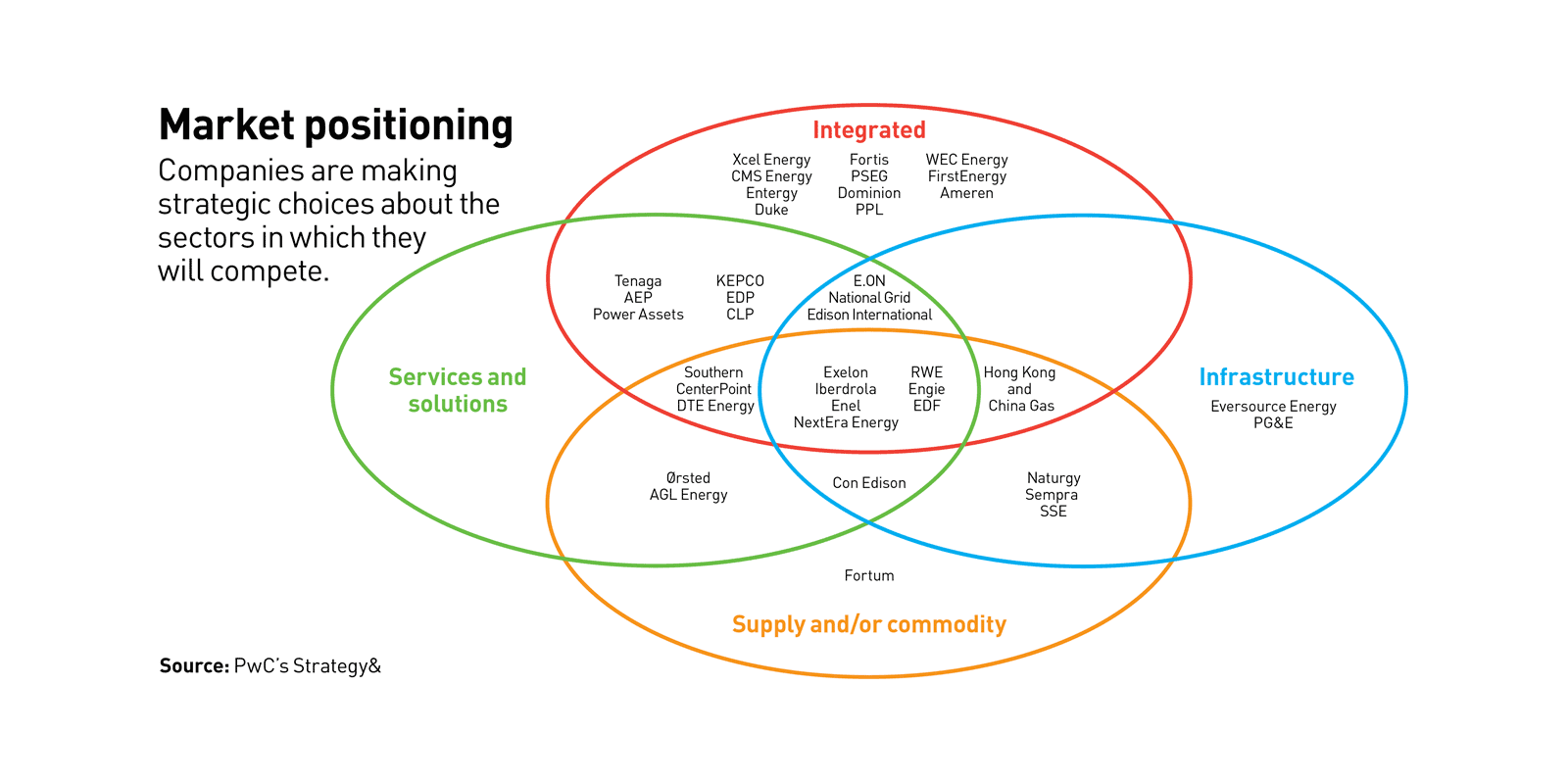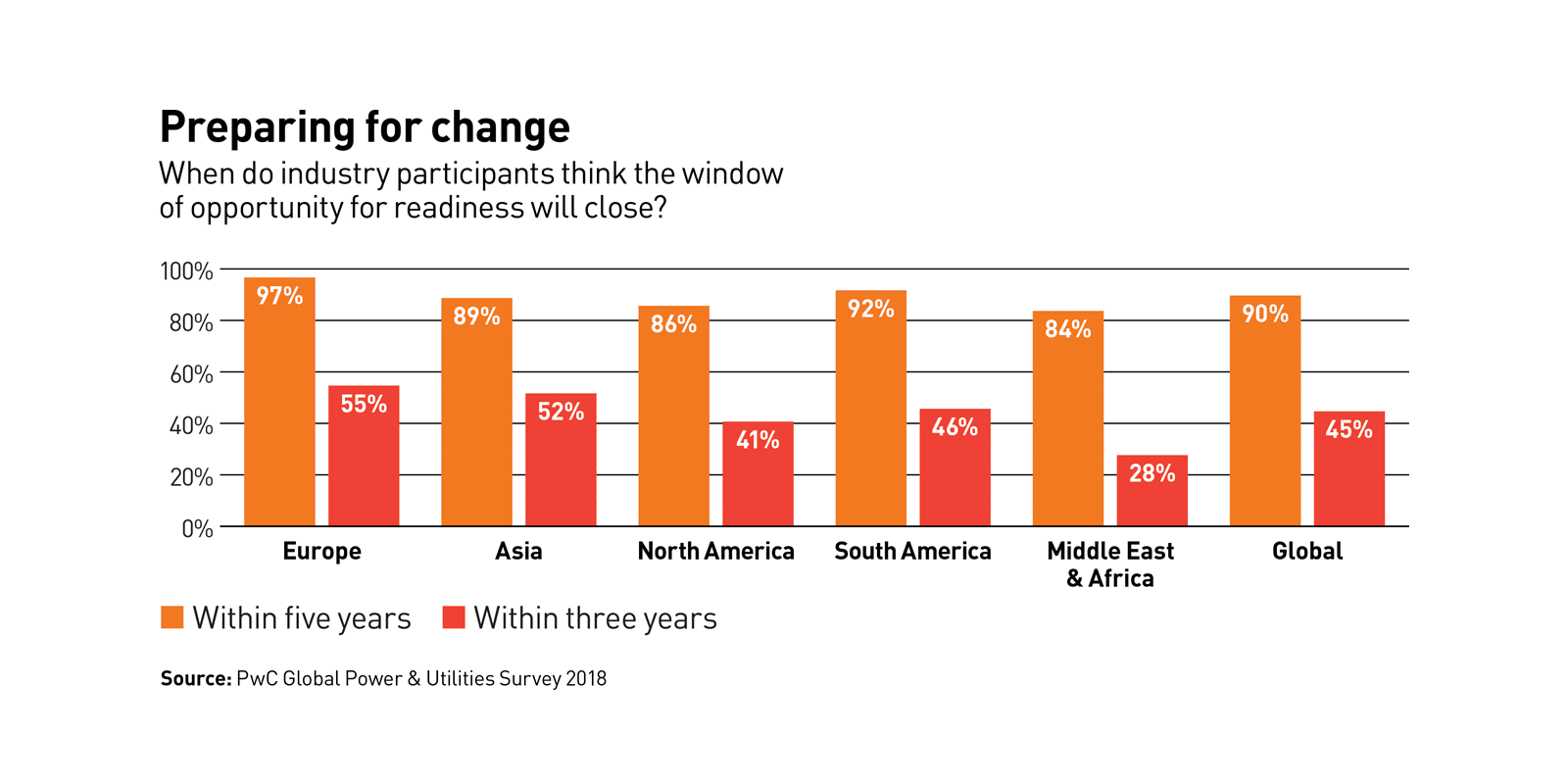Power strategies
The largest utilities around the globe are placing their bets on winning strategies and capabilities.
The vast and vital global power and utilities industry is undergoing a significant transformation. Over the past 30 years, electricity and gas markets have been radically reshaped, thanks to newly opened markets, disruptive competitors and technologies, and the evolution of customers from passive consumers to active participants with high expectations.
The power and utilities sector, which underpins every other industry, has traditionally focused on long-lived assets and gradual policy shifts. As a result, it has adopted changes in a piecemeal, deliberate, and sometimes regulatory-constrained fashion and is not accustomed to an accelerated pace of change. But decarbonization, decentralization, and digitization are creating a new three-dimensional challenge — and impelling faster evolution. Amid rising market uncertainty and increasing pressure on traditional fossil fuel generation, the world’s largest utilities are shifting investments from large-scale power supply into the network. New value pools are forming in areas as diverse as energy management, electric car charging, and home automation. And instead of simply charging a fixed price to deliver electricity, utilities are rolling out pricing models and services more closely associated with consumer goods and industrial companies.
The result? The industry is in the midst of extraordinary strategic ferment, as companies evaluate how they will compete in the future. Some global utilities have already dramatically diverged from their former identities.
To provide a snapshot of peer strategies and an overview of strategic actions and common challenges, we conducted a detailed analysis of the 40 largest utilities by market capitalization in North America, Europe, and Asia-Pacific, a group we call the Global Top 40 (see “The GT40,” below). We have fortified our analysis of elements such as financial capacity, organizational adaptability, market positioning, and innovation adoption with a survey of leaders and managers at more than 100 utilities, and through interviews with several chief executive officers of GT40 member companies. The results illuminate the ways in which utilities are navigating the road ahead and forging a new industry.
The GT40
The selection of the GT40 reflects a desire to illustrate a broad and highly visible peer set across dimensions that apply in contested or traditional markets. Market capitalization in December 2017, based on publicly available information, was adopted as the qualifying metric for the GT40. This metric indicates a scale range of US$12 billion to $73 billion for the peer group and parallels relative positioning across other scale bases (see “GT40 market capitalization”). The focus on a GT40 peer set is a matter of convenience rather than one of bias. Some are fully integrated, some are unbundled into wires or pipes only, some are diversified into related sectors, and some operate on multiple continents. Globally, many different types of players exist — large and small; privately owned and publicly owned; integrated and unbundled; local, regional, national, and international. For the distribution segment alone, more than 7,000 entities exist in 175 countries.
The GT40 represent a total market capitalization of $1.1 trillion at the end of 2017, consisting of 55 percent North American utilities, 34 percent European utilities, and 11 percent Asia-Pacific utilities. NextEra Energy has the largest market capitalization, at $73 billion, and CenterPoint Energy is the smallest utility included.
European utilities are significantly larger than North American and Asia-Pacific utilities in average annual turnover ($37 billion to $13 billion and $15 billion, respectively) and in average number of customers (20 million to 5 million and 10 million, respectively).
Sector performance. The highest market value growth CAGR occurred in North America, where GT40 peers have grown by more than 10 percent annually since 2014. Conversely, GT40 European utilities market value has dropped 1 percent per year since 2014 amid increasing conventional power production costs, intensifying retail competition, and subsidized renewables lowering margins and changing load patterns.
GT40 utilities generated annual revenues (net fuel) of $810 billion in 2017, a decline from $950 billion in 2014, which reflects highly stressed energy markets and various restructuring actions. More than half of total revenue of the GT40 is generated from European utilities. Since 2014, many leading European utilities have experienced revenue declines, primarily due to divestments and the lower dispatch of conventional production capacity. In North America, revenue has remained generally stable due to low price variability.
North America and Asia-Pacific utilities appear to be more profitable, boasting average EBITDA margins of 35 percent and 32 percent, respectively, compared with approximately 20 percent for European players.
These organizations are also highlighting the ways in which the basis for competition is changing. Utilities historically received a valuation multiple premium for the quality of their regulatory environment, management reputation, or financial acumen. Tomorrow, the quality of their strategies may allow utilities to monetize their distinctive positioning into a higher valuation. If utilities are to be successful, their strategies need to be intentional, aggressive, and consequential despite uncertainty over industry outcomes.
Strategy context
Advances in power and gas market structures and disruptive technologies are causing traditional approaches to strategy design to fall short. Meanwhile, utility strategists are coping with a new systemic factor: the encroachment of competitors from adjacent (or nonadjacent) markets that incorporate energy into their market proposition. Technology OEMs, for example, are well placed to compete, and they already produce assets or equipment that customers actively use, such as Nest programmable thermostats or industrial equipment monitors. Software developers, similarly well positioned, offer an expertise-based product not replicable by utilities. And infotainment vendors, oil companies, or electric vehicle OEMs could also easily integrate energy into a larger customer value proposition. These companies bring global reach, financial strength, economies of scale, and mass-market experience to bear to capture market share in the new energy economy.
As a result, developing thoughtful strategies to preserve and extend a utility’s competitive position requires an understanding of how nontraditional competitors approach contested or emergent markets. Utilities, in fact, must fundamentally change the way they approach the development and execution of strategy. Although utilities historically thought about commercialization in windows of three to five years, industrial and consumer companies focus on the next one to two years. Strategy development now likewise needs to emphasize near-term readiness and offerings over long-term preparation and piloting. “We have stopped thinking about growth investments that take more than three years to go live,” said Francesco Starace, chief executive officer of Enel. “In light of the technological transformation, three years seemed to be…long enough to observe a drastic change in the surrounding circumstances.”
Business model choices
A business model links strategy with execution once a company defines where it chooses to participate in the market. But business models, with no true blueprint for design or execution, are more art than science.
Three fundamental value chain segments illustrate how the utilities sector has evolved to enable the integration of natural business activities. The upstream segment includes fuel supply, generation, marketing, and trading. Companies participating in this commodity-driven segment are narrow businesses operating with unique competitive conditions and not included in this study. The midstream segment, the broadest of the three, includes grid, network, and distributed or decentralized supply resources. Most utilities maintain a presence in this segment. The downstream segment includes customer-facing activities such as customer engagement, energy services, and retail. Increasingly, utilities must choose which combination of these three large segments they want to pursue.
Strategy choices
For utilities seeking to devise growth strategies, the options can be broad, depending on their positioning objectives and risk tolerance. Four strategic choices are inherent in a growth options model: expand, enhance, extend, or exit. The underlying business strategy could reflect one or all of these choices, taking into consideration the business starting point, external challenges, and management’s aspirations (see “Growth paths: Defining how to grow”).
Expand the business: creating new sources of load through technologies that appeal to customers and seeking options to scale up the business through inorganic actions, such as making equity investments, which enable utilities to grow from their core.
Enhance the business: improving go-to-market models by building or reinforcing customer relationships and thinking differently about the current portfolio, penetration, and margins.
Extend the business: reshaping customers’ perceptions of utilities’ roles to go beyond energy providers and enter related businesses that enhance customer value, such as energy services, and provide customers more reasons to rely on their incumbent.
Exit the business: recognizing that some assets or businesses can be more capably managed or operated by a different owner.
GT40 utilities have traditionally been active across the value chain in conventional generation, transmission and distribution, and retail. Historically, this vertical integration contributed to significant scale and market presence. But as the utilities sector has evolved through a combination of deregulation, decreasing asset scale, greater competition, and the growth of intermittent resources, the value of full vertical integration has become less apparent.
Many GT40 utilities have now reorganized themselves around specific value chain segments and, in some cases, specific generation technologies, such as renewables. These utilities seek business model clarity and greater certainty in returns.
GT40 utilities cannot look to their peers for new business model concepts and designs; rather, they need to scan the competitive marketplace for successful models. A single business model is not likely to be sufficient to succeed in future markets. It is more likely that utilities will maintain multiple business models tailored to the needs of where they elect to compete and how integration is valued in those models (see “Business model choices”).
Accordingly, utilities need to be adept in managing across multiple value chain segments, each of which could adopt distinct business models to meet discrete market requirements.
Sector shifts
The GT40 utilities have been making tangible changes to manage risk, capture additional value, and modify business models to position themselves for a more coherent future. In general, the mix of capital investment has permanently shifted away from fossil generation and into networks, and innovation has moved from concept to practice with dedicated innovation centers or hubs.
We’ve observed five key trends in these strategic efforts.
1. Merchant market and upstream risk reduction. As the merchant power and gas commodity markets have become more unpredictable, GT40 utilities have reduced their exposure to conventional power generation, particularly coal. Five years ago, coal represented 47 percent of utilities’ power generation mix in North America, 37 percent in Asia-Pacific, and 18 percent in Europe. Today, coal represents 41 percent in North America, 35 percent in Asia-Pacific, and only 12 percent in Europe. GT40 utilities are expected to further shrink their reliance on coal. In the U.S. and Asia-Pacific — but not Europe — utilities have embraced natural gas as the bridge to a future dominated by renewables.
2. Redirected investment to networks and renewables. As they pivot away from fossil fuel–based generation, GT40 utilities are ratcheting up their investment in their networks to boost reliability and accommodate the addition of large amounts of distributed energy resources (DERs). Sustainable energy targets, quotas, and subsidies create attractive opportunities in renewable energy. European utilities are deploying about 30 percent of their capital investment in renewables, compared with only 7 percent for North American utilities. Continued growth in renewables capacity is expected from the GT40 utilities over the next five years.
3. Entry into energy services. Aggressive new entrants are responsible for significant activity in the solutions and services segment. Across all regions, GT40 utilities are actively building out go-to-market positions with behind-the-meter B2B and B2C products and services. These products and services typically extend across several value pools, such as DERs, e-mobility, smart home, and commercial and industrial energy services. “We believe CenterPoint Energy will lead the way by distinguishing ourselves among our peers through offerings and services that reinforce our reputation as a trusted energy delivery company and advisor to our customers,” said Scott Prochazka, president and CEO of CenterPoint Energy. More than half of European GT40 utilities offer products and services across these value pools through owned businesses or as incumbent providers. European utilities are farthest along in developing their market offerings, often through major investments in third-party acquisitions. As examples, in 2017, Engie acquired vehicle-charging company EV-Box and Enel purchased EnerNoc, a U.S. energy management services company. Other than DERs, most energy services offerings are typically less developed for North American utilities, which believe they have more time to prepare to offer value-added products and services.
4. Innovation capacity and capabilities. Large utility companies are making significant investments in facilities and talent devoted to innovation. Electricité de France (EDF) has the broadest physical presence, with 10 global regional innovation and R&D hubs, followed by such European peers as Enel, Energias de Portugal (EDP), and E.ON with eight each. These innovation centers collectively address microgrids, e-mobility, digitization, and batteries, among other specialized technologies and applications.
By contrast, North American players typically have a dedicated innovation capability supporting their business. Several utilities, such as Southern Company, Ameren, and Exelon, created stand-alone innovation centers or hubs to conduct work in concert with external solutions providers. In Asia-Pacific, Korea Electric Power (KEPCO) has created an “energy valley” where it is anticipated hundreds of energy innovators can collaborate.
5. Rationalization to support strategy adoption. Over the past two years, European utilities have been actively repositioning their businesses to reflect strategic challenges and ready themselves for market opportunities through restructuring programs. “In 2016, we split our company,” said Johannes Teyssen, chief executive officer of E.ON. “We established two independent companies: one company, Uniper, with a focus on conventional, large-scale generation, and another company, the new E.ON, with a focus on renewable generation, energy networks, and customer solutions.” Then, in 2018, E.ON and RWE agreed to swap assets to bring further clarity to their business models. Accordingly, E.ON will acquire the grid and retail businesses of RWE and Innogy in exchange for the renewable and other power-generating assets of E.ON. Denmark’s Ørsted is aggressively selling assets — including conventional generation and distribution businesses — to transition its business model toward full renewables.
Strategy execution
We’ve also identified five elements GT40 utilities are pursuing as levers to help them stand out: differentiated strategy, inorganic growth, organization adaptability, innovation advancement, and business models.
Differentiated strategy. Strategies pursued by utilities often read alike given the similarities of their integrated or segmented businesses. GT40 utility models include heritage integrated models, restructured infrastructure (grid and network) models, and adjacent focus in either solutions and services or supply and commodity, or both.
A single business model is not likely to be sufficient in future markets. It is more likely that utilities will maintain multiple business models tailored to the needs of where they elect to compete and how integration is valued in those models.
But differentiation occurs in how these utilities segment the value chain into addressable sub-elements, such as energy services, electric transportation, and DERs. Thus far, European utilities such as Engie, E.ON, RWE, and EDF are outpacing their North American and Asian peers, which are engaging these markets more cautiously. Southern Company, Edison International, and American Electric Power (AEP) are active in pursuing new energy services markets and enhancing their customer value. North America–based utilities, such as Dominion Energy and Sempra, are also active in the natural gas sector, including midstream pipeline and storage and natural gas facility development. Certain Asian utilities, for example, Hong Kong and China Gas Company, and Power Assets, also focus on natural resource activities in natural gas.
Inorganic growth. The global utilities industry has steadily consolidated since the early 1990s when country, province, and state policies began to dictate functional unbundling and separation of certain assets and customers. The number of electric and gas utilities in North America has declined by about 65 percent since 1995; in Europe, consolidation has led to the creation of very large national champions, many of which operate in multiple countries (see “GT40 global presence”). The utilities sector is now in another stage of inorganic activity, with a focus on growth in new energy areas, such as energy services and renewables, and a transfer of assets, such as conventional supply, to more natural owners.
GT40 members, including Xcel Energy and NextEra Energy in North America, Iberdrola and EDP in Europe, and KEPCO and Tenaga Nasional Berhard in Asia, have built their supply portfolios by developing or buying renewables to meet mandates, revamp sources, or satisfy the sustainability commitments of their largest customers and other public stakeholders.
The next stage of inorganic growth will come through capabilities expansion, e.g., product development, pricing, and channel management, all of which will enable participation in areas critical to long-term positioning. In North America, Edison International and National Grid USA have been early movers in acquiring or investing in startup companies and solutions providers that bring capabilities to the energy services space.
A dozen utilities in North America, Asia, and Europe have committed funding to Energy Impact Partners (EIP), an energy-focused venture fund that nurtures early-stage technology-based solutions providers. This has led to investments in emerging disruptors such as Ring, Greenlots, Tendril, and EcoBee. Other members of the GT40 manage or engage with similar private venture funds.
Organization adaptability. Traditional utilities models were designed to meet operating needs centered on segments, such as supply and transmission. Today, utilities are realigning their resources, including strategy, innovation, digital, networks, and offerings, to meet requirements imposed by markets.
Several utilities, including EDF and Engie, position the strategy officer as a direct report to the chief executive officer to signal the importance of the role to enterprise growth. The same is true for innovation; senior officers at Dominion Energy and Xcel Energy maintain responsibility for instilling an enterprise view into the operating businesses.
Other European utilities, such as E.ON, have shifted away from a traditional segment focus, combining related operating assets into diverse infrastructure models focused on delivery. These utilities view the business from a network perspective that emphasizes connectivity and deriving value from asset operations, not just deployment.
Similarly, EDF and RWE have shifted their thinking from a customer service–based model to one that emphasizes customer solutions, the customer experience, and the creation and offering of services to meet customer needs. Others are rethinking the balance between activities that are centralized and those that are decentralized. “Increasingly, customers expect solutions that are tailored to their region,” said Isabelle Kocher, chief executive officer of Engie. “This is a new phenomenon for an industry that used to take a centralized approach to power generation.”
Several utilities in North America are also rethinking these legacy segments. Duke and PG&E are increasing their emphasis on grid and infrastructure value. And AEP, Xcel Energy, and CenterPoint Energy have elevated their view of the customer beyond bill collection to the delivery of solutions. These structural shifts are just beginning within the peer group and reinforce the organization model as a valuable element of enhancing go-to-market strategies.
Innovation advancement. Embedding a culture of innovation takes time and patience, often requiring multiyear coaching and platform development. Most utilities initially focus on operational innovation through technology adoption; others frame the challenge as new revenue creation, a broader value proposition to the customer, and clear market positioning. Across the GT40, European and North America utilities have been active in innovation. These models range from one-time executive officer–led initiatives to galvanize the employee base to sustained efforts to engage the organization through visible actions.
In North America, utilities have realized that a robust innovation platform requires sustained commitment and constant executive leadership visibility. Companies including Southern Company, Dominion Energy, Exelon, NextEra Energy, and Duke have utilized formal events to engage their employee base in ideation. And several are moving to create dedicated innovation spaces that facilitate collaboration with third parties.
Business models. The range of business models adopted for pure-play utilities has historically been narrow. But business model design is advancing as utilities gain experience with new businesses, offerings, channels, and customers. The roles that utilities play in these businesses define market purpose and the offering mix shapes nontraditional pricing options.
Whether they are participating in natural gas, large- or small-scale DERs, or behind-the-meter value, utilities have the potential to create new sources of value and capture additional profitability.
Pricing options, which historically centered on shared value from performance, now extend to include more negotiated value-based outcomes, fee-for-service, access charges, and variable pricing approaches tailored to match roles, activities, outcomes, and risks. Electric transport provides a similar opportunity for utilities to consider how to play in advancing the market and supporting customers, particularly at the commercial fleet level. For instance, the electric transport value chain consists of nine elements, including promotion, infrastructure, and after-market services; eight of these elements contribute value.
Solutions and services
The GT40 utilities are widely arrayed in their differentiation and growth. European utilities hold the high ground on solutions and services, with selected North American peers and Asia-Pacific utilities following a similar path (see “Market positioning”). Most utilities occupy the integrated space, paying growing attention to services and solutions through competitive businesses. Others are infrastructure utilities that may own competitive businesses in retail or provide residential, commercial, or industrial customer services in some form. Few utilities are pure-play asset operators without related business components.
In Europe, some utilities, such as E.ON, Engie, and Enel, have emphasized the creation of new revenue streams from solutions and services businesses, whereas others, including Ørsted and Fortum, emphasize supply and commodity.
A number of North American utilities are forging solutions and services models through acquired companies, product and service introduction, and targeted market partnerships. Southern Company, Duke, and Ameren all leverage third-party relationships to support offering development and market participation. AGL Energy in Australia specifically focuses on supply and commodity, with some attention now directed toward solutions and services that enhance the value of the commodity and brand.
Sharper externalities
Facing a world where markets, customers, and strategies have transformed, the GT40 utilities must come to grips with another challenge: The externalities that help define and influence their operations are becoming sharper. Their rising power heightens the sense of urgency utilities feel to develop innovative offerings and bolster their go-to-market position. Regulation is the most obvious externality. “Fortis does not seek exemptions from regulation but does seek to control its own destiny. Our approach is to work collaboratively with regulators for the benefit of customers, to honor the process, and to be transparent,” said Barry Perry, chief executive officer of Fortis.
Other externalities are growing in importance:
Capital markets. Low interest rates, partially a function of central bank efforts to promote growth, are rising — which effectively increases the cost of investment. Several utilities in North America, including FirstEnergy and Sempra, have recently experienced targeted acquisition of shares by market funds seeking to push for greater shareholder value realization. Disruptive by design, these investors can radically alter growth plans.
Technology advancement. The technology landscape is evolving from one that is analog, centralized, and standardized to one that is digital, distributed, and personalized. As emerging technologies proliferate and improve, utilities need to become more adept at deployment and configuration. That doesn’t necessarily mean they have to grow new technologies on their own. “AGL is a fast follower, not a product developer,” said Brett Redman, chief executive officer of AGL Energy. “We have strong capabilities in helping our customers make good choices and putting in place the supporting systems and processes.”
Customer actions. The global utilities sector finds itself outpaced by both its customers and its competitors. Customers seek solutions, whether from incumbent providers or other sources, and competitors see incipient market opportunity to exploit areas where traditional providers leave demands unfulfilled. As customers shift from digital adopters (baby boomers) to digital natives (millennials), they will increasingly demand real-time solutions to their challenges. “Customers expect reliable, quality, and consistent service. But they are now looking for stronger relationships with their incumbents, and AEP is focused on changing how it is perceived in the market,” said Nick Akins, chief executive officer of American Electric Power.
Unnatural competitors. Globally recognized, ubiquitously present, and highly admired brands such as Shell, Total, Chevron, and AT&T recognize the attractive scale of the global utilities sector. At the same time, challenger brands such as Hive, Nest, Tesla, and Bloom have quickly built powerful market recognition. Utilities need to understand how these players are shaping markets and whether they are market enablers, suppliers, competitors, or future partners.
Directional headings
The paths the GT40 will take naturally vary, matching the policies, requirements, and potential of localities where they operate. Numerous countries have already paved a road map for open markets, technology substitution, and more competition, and others will follow. With many of the GT40 operating in multiple countries or service territories, market solutions offered and opportunities captured in one location will rapidly travel to where comparable conditions exist.
But utilities need to move quickly. Despite the accelerating pace of change, 90 percent of the respondents in our 15th Global Power and Utilities Survey said they believed the sector has as much as five years to prepare for upheaval, but almost half the respondents said they believed that the window of opportunity might last only three years (see “Preparing for change”). It is likely they will not have that much time.
Nonetheless, 82 percent are not ready now and 44 percent won’t be ready by 2020. An opportunity for natural growth could easily be squandered in this time frame.
To make sure they don’t miss the window, utilities have to quickly develop some of the capabilities necessary to thrive in the emerging market. These include:
Market shaping. Going forward, it will be strategically inadequate to passively respond to markets as the sector has historically done. For utilities to develop great ideas into commercial products, they will have to think like the FAANGs (Facebook, Apple, Amazon, Netflix, and Google), and develop the capacity for continuous market sensing, constant innovation, a commercial mind-set, aggressive branding, and speedy decision making. These are traits utilities are only now nurturing.
Virtual supply. Although global exceptions exist in Asia and India, most utilities are moving farther away from fossil fuels as a primary or even secondary fuel source.
A potential long-term solution — to conventional and unconventional supply sources — is storage in combination with renewables as a virtual power plant that fulfills the needs for supply, resiliency, and security.
The virtual power plant harnesses distributed generation and creates an innovative new model. The “big battery” in South Australia combines Tesla technology with Neoen wind farm performance to deliver a supply security solution, while allowing the asset to invigorate an emerging frequency control market in Australia. Players such as E.ON, NextEra Energy, and AGL are all investing in this space.
Platforms and solutions. For years, the utilities sector saw its network assets as a mosaic of equipment rather than an intelligent, integrated network. But utilities can now use software deployed through the network to optimize functions and create platforms that enable the provision of services. Through the installation of sensors, controllers, and intelligent data platforms, digitization enables energy brokers, aggregators, demand managers, and price comparison services to provide services that customers value.
Home hubs. A significant technological shift will occur in the home as new players focus on creating ubiquitous market positions in a large and underserved customer group: residential customers. These customers will be served through technology applications in the form of home hubs offering a range of services — not just for power and gas, but also for telecom, entertainment, information, security, smart home, and other areas. Beyond the FAANGs, which already serve millions of residential customers, AT&T and Comcast in the U.S. and other global telecom and infotainment companies in Europe and Asia-Pacific are engaged in elements of this mass-market space.
Value models. As GT40 utilities learn to compete in a broader products and services marketplace, they will find that many customer offerings do not fit in a traditional regulated business. Consequently, utilities will present not just products or services, but a portfolio of offerings to customers. This means utilities need to become adept at packaging multiple offerings and pricing them as a bundle, where beneficial.
With bundles, utilities will need to develop pricing dexterity that recognizes and incorporates risks into the pricing model. Risk-adjusted margin evaluation will become a critical enabling skill for creating business models that link pricing to customer value requirements.
Product and service pricing needs to be a core capability. Utilities must dramatically elevate their thinking about how to act commercially, rather than as an unsophisticated regulated incumbent. This mind-set is fundamental to meeting customer expectations for demonstrated value.
Future actions
Thus far, utilities have tended to pursue strategic actions with a relatively high degree of confluence. Over the next several years, it is likely that some separation will occur between the most aggressive and innovative GT40 utilities and their peers. The degree of separation will likely enable investors to value utilities differently on the basis of their strategies and market accomplishments.
At present, the European GT40 utilities lead their North American and Asia-Pacific counterparts, primarily because of earlier policy shifts and restructuring efforts. But the North American and Asia-Pacific GT40 utilities are following the same general path. Over the coming years, the members of the GT40 will likely advance their strategic initiatives to include more capabilities-based acquisitions, more partnering with OEMs and solutions providers, and more innovation in business models.
Although directional headings seem clear, the possibilities of unexpected policy changes, accelerated technology availability, and customer-driven market evolution will refine these strategies — sometimes as planned and sometimes quite unexpectedly.
Author profiles:
- Tom Flaherty advises companies in the global power and utilities industry on strategy for Strategy&, PwC’s strategy consulting business. Based in Dallas, he is a senior advisor with PwC US.
- Paul Nillesen leads the Dutch energy practice for both Strategy& and PwC. Based in Amsterdam, he is a partner with PwC The Netherlands.
- Mark Coughlin leads PwC’s Australian energy, utilities, and resources practice. Based in Melbourne, he is a partner with PwC Australia.
- Also contributing to this article were Tom Haddon, manager with PwC UK; Kaspar Hebblewhite, manager with PwC The Netherlands; and Justine van Berckel, associate with PwC The Netherlands.



